Saya Tidak Mau
During all of my wanderings around Bali, I found the local populace to be uniformly pleasant, friendly and always smiling. However, after a while, the constant barrage of hawkers who would invariably swarm all over me began to wear me down a bit. The small army of scammers lurking in the temples awaiting the entry of unwary visitors has been
very well documented so it was not as if I entered the fray totally unprepared.
Perhaps this issue would have been less of a problem for me had my driver been able to accompany me into the temples but he was forbidden to do so until he was no longer considered “unclean.” The bottom line is that I was invariably left to my own resources to thwart the scammers. And I often found myself spending more time defending myself from hassles and cons than I did engaging in my main objective, which was just to wander around a bit, enjoy the scenery, contemplate my surroundings in silence and take a couple of thousand pictures.

I solicited the advice of my driver and he responded by teaching me a few important phrases in
Bahasa Indonesia and this turned out to make quite a bit of difference in all of my future forays. I quickly learned to say,
Saya Tidak Mau whenever I was approached by annoying hawkers, touts, scammers and con artists. My new mantra literally meant, "I don't want it" and it was quite effective at diffusing these unwelcome intrusions at least 90% of the time. For greater efficiency, I also wrote down the phrase on a pad of paper, which I dutifully inserted in my shirt pocket so it was always on full and proud display on all occasions. And even for those times in which it was not always fully effective at dissuading everyone, it was
invariably good for a laugh amongst the local populace.
As I continued my journey, I soon learned to refine my responses just a little bit more. I thought back to my earlier conversation with the Australian expat during my first afternoon in
Nusa Dua and recalled his detailed description and analysis of the types of questions asked by the local populace in an effort to size up how much a particular tourist is good for. Whenever I was asked where I was from, I responded by saying,
Saya dari Bangli, having previously learned that
Bangli was the site of Bali's only
mental hospital,

from which I had recently
escaped.
 Tegenungan Waterfall
Tegenungan Waterfall
Not very far from
Ubud, we came upon a cliff overlooking the
Tegenungan Waterfall. The area had been in the process of evolving into a tourist destination and in short order, a luxury resort had sprouted up overlooking the falls, accompanied by something that
every world class resort needs, a
bungee jump. This all came to an abrupt end after the
bombing in Kuta and now both the resort and the bungee jump have been abandoned.
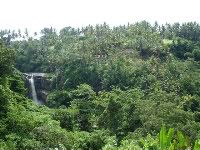
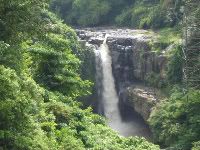
Our next stop was
Pura Penataran Sasih, known locally as the
moon temple, situated in the village of
Pejeng, fairly close to the town of
Gianyar. Its main sanctum houses an ancient bronze kettledrum, the largest such instrument in the world cast as a single piece. According to local legend, this artifact was actually the wheel of a chariot that was used to transport the moon across the heavens and then fell to earth, its fall broken by a tree in
Pejeng. Its light shown as brightly as the moon, to the great consternation of a local thief, who tried to extinguish the light by urinating on it. The wheel exploded and dropped to the ground and killed the thief, taking on its current form as a kettledrum, broken at its base as a result of the fall. From what I understand, the Balinese are always very careful whenever they approach the "Moon of Pejeng" and I would imagine that they probably tend to pee quite far from it too.
 Lord of the Flies
Lord of the Flies
As a heathen visitor, I was not as much impressed with the moon temple as I was with some of the incredibly intricate fruit carvings and statues that stood guard throughout the grounds of the moon temple complex. The skill and handiwork were quite amazing and, judging from the smell, some of the fruit was beginning to get a little ripe. As a consequence, I would imagine that the flies were quite amazed with the fruit carvings as well.


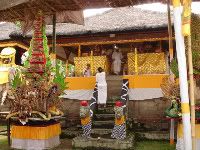
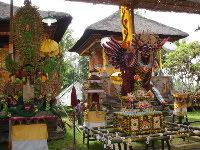
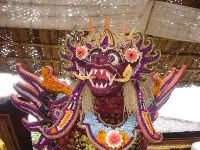

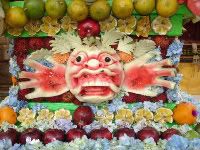 Kertha Gosa
Kertha Gosa
About 40 kilometers northeast of
Denpasar, lies the city of
Semarapura, in the regency of
Klungkung.
Semarapura is also the site of the infamous
puputan, a mass suicide committed by the Balinese in 1908 when the Dutch invaded the town. Right in the center of the city resides
Kertha Gosa, the "Hall of Justice," an expansive park containing a courtyard and a "floating" temple, surrounded by lotus blossoms designed to evoke the feeling of an "island of splendor" set within an ocean. At one time, the structure was used as a waiting room for those who had come to see the king.
The ceiling of this temple is well known for its paintings depicting the story of
Bhima Swarga, which literally translates into "Bhima goes to the abode of the gods.” In the story, which is a component of the epic
Sanskrit poem, the
Mahabharata,
Bhima has been asked by his first mother to journey to hell to rescue the souls of his father and second mother so off he goes with his siblings and some servants. When he gets there, he frees his parents from a cauldron of boiling water and off to heaven they go. This really ticks off the resident demons to no end so he has to fight all of them. It turns out the Gods are none too thrilled with him either so he fights them too but is killed. However, the high God brings him back to life. The 2007 blockbuster film,
Bhima Swarga - The Journey Of The Soul From Hell To Heaven is available for download and purchase.
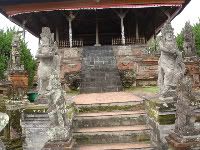
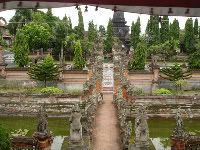
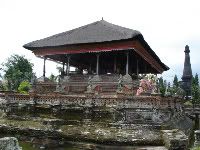
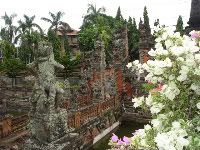

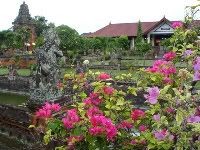 Tirta Gangga
Tirta Gangga
As we meandered towards the east coast of Bali, we passed many beautiful vistas, including rice paddies, some smaller temples and an interesting array of fanciful offerings. My favorite offering to date was what I fondly dubbed "Mr Jackfruit Head," and I briefly wondered to myself whether
Playskool might be inspired to incorporate it into their product line.
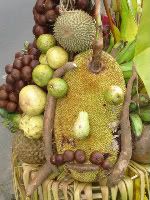

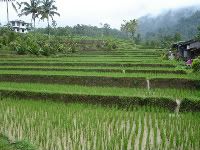

When we arrived at the beautiful
Tirta Gangga water garden nestled in the middle of rice fields near the slopes of the volcano,
Mount Agung, things were looking up. Although the sun was fully obscured behind clouds, it wasn't raining and there was nary a monkey to be seen. I was beginning to feel dejected that the monkeys didn’t love me anymore.

The hawkers and scammers seemed to like me just as much as ever and they were deployed in full force. However, I felt that I was quite well prepared for them by now.
The water garden complex was built distant ages ago, all the way back in 1948 by the King of
Karangasem,
Anak Agung Anglurah Ketut as place to bathe and relax. It was completely destroyed when the volcano erupted in 1963 and the area was abandoned for quite some time but many sections have since been restored. The water derived from the springs that feed into the water garden are considered by the Balinese to be holy and, indeed,
Tirta means “blessed water” and the word
gannga is derived from the
Ganges river in India. The water generated by the springs is pure enough to constitute the main source of drinking water for the nearby town of
Amlapura.
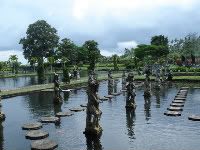
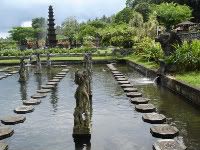
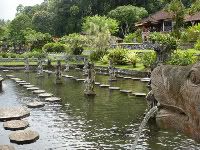

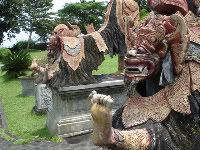
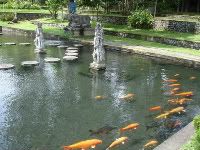
From
Tirta Gangga, we drove northeast, arriving on the east coast of Bali near the fishing village of
Amed. The copious rice terraces that were so quintessentially emblematic of the interior of Bali, soon gave way to other types of crops, including corn and cattle. I was surprised to learn that there is even a small
wine producing region on the northern coast of Bali near
Singaraja.
From
Amed, a single narrow road wends its way along the coast south towards another fishing village,
Candidasa. The road hugs the coast, closely following all of the circuitous contours of the bays, coves and hills. In many areas, broad overlooks afforded us sweeping vistas of cliffs dropping precipitously to the churning ocean below, whereas in other places, calm coves embraced smooth and serene black sand beaches. Some areas were devoid of all signs of humanity, whereas others places were tightly crammed with fishing boats, obscuring all but a few grains of sand.
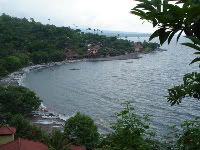
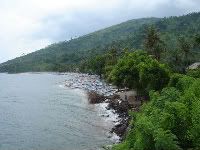

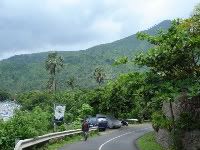
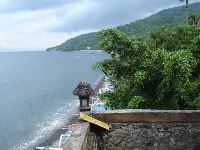
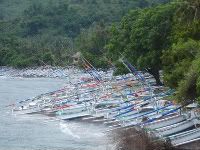
My driver asked me whether I was interested in visiting one of the many salt producing huts that dot the coastal area near
Kusamba, a small fishing village near
Amlapura. He explained that the seawater is percolated through salty black sand and then set out in large coconut-log troughs, where it evaporates into a briny slush. It is further processed into coarse white crystals that are used for salting fish. I respectfully declined, figuring that observing salt production would be the equivalent of watching paint dry and
that is something I could see any time I wanted.

Besides, I have never been terribly fascinated with salt; fresh ground pepper is more my thing, which is not at all surprising given my penchant for deploying a
pepper mill on all my UA flights.
Our drive took us past many small villages, some sparsely populated, others rife with throngs of people going about their business. In one village, the street was packed with a hundred or so men, mostly clustered near one particular building. I could see other men pouring into the area as we slowly struggled to squeeze our car through the throng. When I asked my driver if he knew what was going on, he replied, “
Cock fight.” Though officially illegal in Indonesia, it is actually quite common in the villages, a source of entertainment and a considerable amount of gambling. As with many customs in Bali, even cockfighting has its religious origins. It is believed that the blood spilt during the battle will appease the evil spirits known as
Bhuta and Kala, thereby ensuring a high crop yield for the village. And afterwards, the losers wind up as dinner as they are thrown into the cooking pot.
Elsewhere, women walked along the road carrying impossibly large burdens on their head, huge herds of uniformed children happily fled from school, and lots of “free range” chickens and dogs wandered everywhere, the latter often choosing to nap right in the middle of the road. This seemed very curious to me because it was not as if there was a paucity of vehicular activity. I spotted more than a few other cars during our journey and motorcycles were always in abundance.
The odd thing about some of the dogs was that they would often not budge as our car approached, reluctantly crawling away at the very last minute and sometimes they would not move at all. I discussed this with my driver as we slowly meandered around a narrow bend in the road wending its way through a very small village. At that moment, a motorcycle careened around the bend and struck a large white dog that had been snoozing in the middle of the road. I was amazed that the motorcycle rider, though wobbling a bit, never fully lost his balance and, after only the briefest of hesitations, continued on his way. The dog, quite sadly, was not as lucky. Nearby villagers walked over to look at the carnage and other dogs trotted over to sniff at the convulsing victim. It was quite a horrific site, rendered even more so because the poor thing did not die right away.
 For Whom The Road Tolls
For Whom The Road Tolls
We drove a bit further along the road and soon found ourselves back at sea level. A very small river trickled into the ocean but there was clear evidence that the volume of water had been much more forceful quite recently. Much of the road had been washed away, so it was somewhat of a tight fit for our car to make its away through. Not that the passage was particularly dangerous given that the “precipice” could not have more than six inches or so above the adjacent terrain. Nevertheless, a couple of enterprising young boys, neither more than 12 years old, appointed themselves toll takers and dutifully collected a fee from my driver in order to guarantee safe passage.

We continued on our way and shortly came upon a section of the road situated near a considerably larger river. Indeed, that portion of the road was entirely submerged, I would estimate at a depth of one foot or so. We plodded on through the muddy effluent anyway and soon left it all behind us we gained a bit of altitude and then parked in a convenient overlook that afforded us with splendid views of the
Lombok Strait.
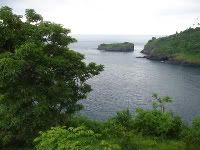
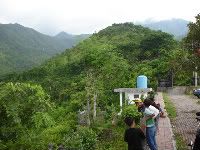
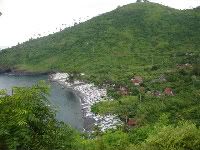
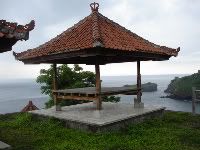
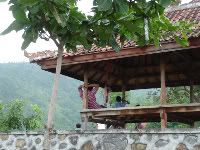
As we pulled away from the parking area, I asked my driver whether we would be taking this road all the way south. He explained that such a trip would take much too long because of the poor condition of the road. Given the road conditions that we had already experienced thus far, I would imagine that he made a very wise decision. So we retraced our steps back, including another blockade by the youthful toll takers, who dutifully tried (and failed) to extract another fee from us. After a while, the road improved and we worked our way towards our next destination,
Goa Lawah, stopping only briefly to observe a man go for a swim in a slimy pond near the beach.

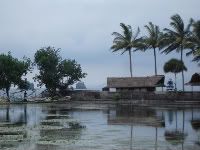
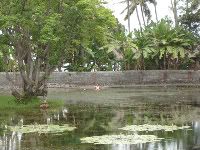 Holy Bat Cave
Holy Bat Cave
Located on the eastern coast of Bali, the bat cave at
Goa Lawah provides shelter for thousands of fruit bats, who are, in turn fed upon by the legendary giant snake,
Naga Basuki. According to local legend, several hundred years ago, there was a dispute regarding the legitimacy of
I Gusti Ketut Agung as a true descendant of the
King of Mengwi. The
King of Klungkung told
I Gusti Ketut Agung that if he survived a foray into the bat cave, he would be recognized as a true member of the
King of Mengwi's family. He survived the challenge and ultimately emerged, for some reason completely deaf, at
Besakih, 19 miles way.
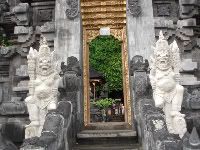
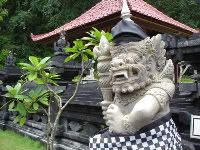
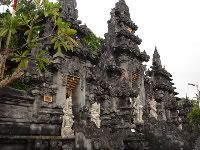
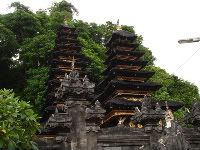
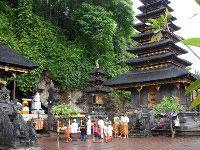
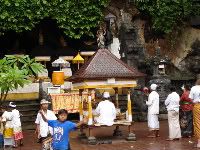
Plenty of bat guano exuded from the cave, which might explain why
Batman failed to make an appearance. Nevertheless, quite a few worshippers had assembled to pray and make offerings.

From the
Bat Cave, we started the very long ride back to
Nusa Dua. Soon enough, the skies began to darken ominously and as we came within the vicinity of
Kuta, it began to rain torrentially, as is clearly the custom here. Once we found ourselves on the
Ngurah Rai Bypass, our side of the road had become a veritable river but that was
dry compared to conditions on the other side of the road. In fact, the water was so deep in some sections of the road, that much of the northbound traffic just decided to abandon their lanes and annex portions of the southbound side.
After several days of observing the often chaotic Balinese road system, my observation has been that even under the best of conditions, road lanes are merely an often-ignored suggestion, much akin to traffic lights for a New York City cab driver. In reality, a two lane road often winds up supporting three or more lanes as cars and motorcycles constantly jockey for position in order to seize whatever limited space they can for themselves. Needless to say, adding the extra nuance of opposing traffic made for a
very interesting ride back to the hotel.
 Continued …
Continued …